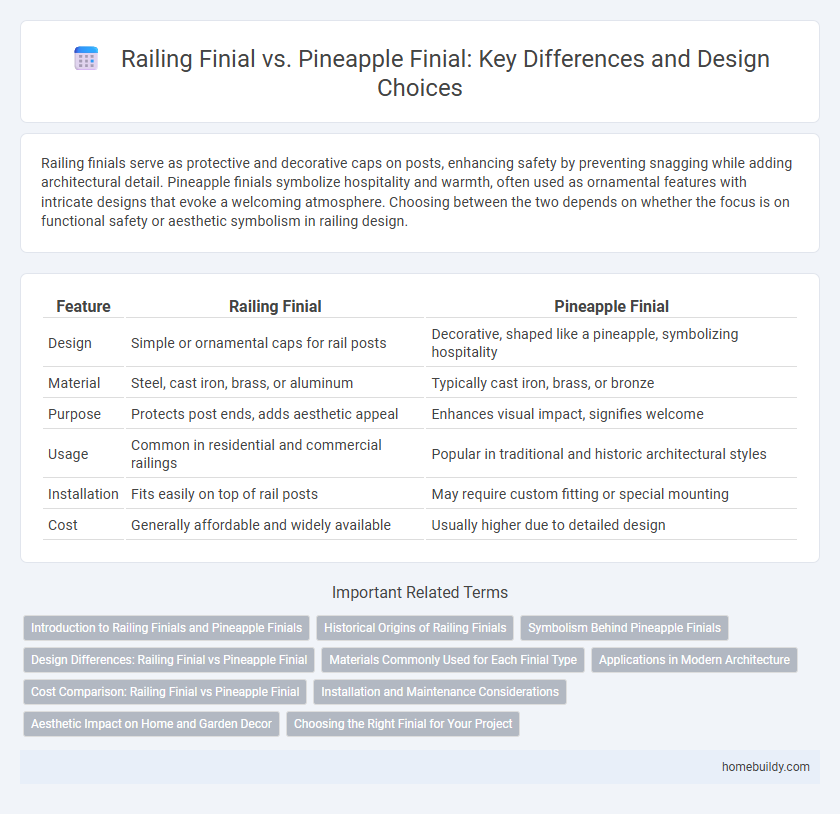Railing finials serve as protective and decorative caps on posts, enhancing safety by preventing snagging while adding architectural detail. Pineapple finials symbolize hospitality and warmth, often used as ornamental features with intricate designs that evoke a welcoming atmosphere. Choosing between the two depends on whether the focus is on functional safety or aesthetic symbolism in railing design.
Table of Comparison
| Feature | Railing Finial | Pineapple Finial |
|---|---|---|
| Design | Simple or ornamental caps for rail posts | Decorative, shaped like a pineapple, symbolizing hospitality |
| Material | Steel, cast iron, brass, or aluminum | Typically cast iron, brass, or bronze |
| Purpose | Protects post ends, adds aesthetic appeal | Enhances visual impact, signifies welcome |
| Usage | Common in residential and commercial railings | Popular in traditional and historic architectural styles |
| Installation | Fits easily on top of rail posts | May require custom fitting or special mounting |
| Cost | Generally affordable and widely available | Usually higher due to detailed design |
Introduction to Railing Finials and Pineapple Finials
Railing finials serve as decorative caps placed atop railing posts, enhancing both aesthetics and safety by preventing blunt edges. Pineapple finials, a popular subset, symbolize hospitality and are distinguished by their intricate, textured design resembling a pineapple fruit. Both types play a crucial role in architectural detailing, offering style variations that complement different design themes.
Historical Origins of Railing Finials
Railing finials trace their origins to medieval Europe, where they served both decorative and functional purposes atop iron and wooden railings to prevent water ingress and deter climbing. Pineapple finials, a distinct design symbolizing hospitality and wealth, emerged in colonial America during the 17th century, largely inspired by European motifs but gaining unique cultural significance. The historical evolution of railing finials reflects shifts in architectural styles and regional symbolism, with pineapple finials representing a specific subset within this broader decorative tradition.
Symbolism Behind Pineapple Finials
Pineapple finials symbolize hospitality, warmth, and welcome, making them a popular choice for decorative railing finials in residential and commercial architecture. Unlike plain railing finials, pineapple finials carry historical significance rooted in colonial America and European traditions where the fruit represented luxury and generosity. The intricate design of pineapple finials adds a unique, inviting aesthetic that enhances the overall visual appeal of staircases and outdoor railings.
Design Differences: Railing Finial vs Pineapple Finial
Railing finials typically exhibit streamlined, geometric shapes designed to complement modern or traditional balustrades, while pineapple finials feature intricate, textured patterns symbolizing hospitality and warmth. The design of railing finials often emphasizes simplicity and uniformity for architectural cohesion, whereas pineapple finials serve as decorative focal points with their detailed, organic form. Material choices for both vary, but railing finials frequently utilize metals like wrought iron or brass for durability, contrasted by pineapple finials commonly crafted from wood or ceramic to highlight craftsmanship.
Materials Commonly Used for Each Finial Type
Railing finials are commonly crafted from durable metals such as wrought iron, stainless steel, or aluminum to ensure longevity and resistance to weather conditions. Pineapple finials, often symbolizing hospitality, frequently utilize materials like cast iron, brass, or resin, allowing for intricate detailing and varied finishes. Both finial types prioritize material selection based on aesthetic appeal and functional durability in architectural applications.
Applications in Modern Architecture
Railing finials are essential decorative caps that enhance the safety and aesthetic appeal of staircases and balconies in modern architecture, often featuring sleek, geometric designs suitable for minimalist styles. Pineapple finials, symbolizing hospitality and tradition, are predominantly used in classical and colonial-style buildings, serving as ornamental focal points on gates and fence posts. While railing finials prioritize functionality combined with contemporary aesthetics, pineapple finials emphasize cultural symbolism and historical elegance in architectural applications.
Cost Comparison: Railing Finial vs Pineapple Finial
Railing finials typically offer a more budget-friendly option compared to pineapple finials, with prices often ranging between $10 to $50 depending on material and design complexity. Pineapple finials, known for their intricate detailing and classic appeal, generally cost between $40 and $100 or more, reflecting their ornate craftsmanship and decorative value. Choosing a railing finial provides cost efficiency without sacrificing aesthetic appeal, while pineapple finials add a premium ornamental touch with higher investment.
Installation and Maintenance Considerations
Railing finials offer straightforward installation with universal compatibility for various railing types, requiring minimal tools and time, whereas pineapple finials often demand precise alignment and specialized mounting hardware due to their intricate design. Maintenance of railing finials typically involves simple cleaning and occasional repainting to prevent rust or corrosion, while pineapple finials, crafted from detailed metalwork or resin, require more careful upkeep to preserve their ornamental features and prevent damage. Selecting between these finial types hinges on balancing ease of installation and routine maintenance against aesthetic preference and design complexity.
Aesthetic Impact on Home and Garden Decor
Railing finials offer a sleek, classic look that enhances the architectural lines of staircases and balconies, emphasizing structural elegance in home and garden decor. Pineapple finials symbolize hospitality and add a distinctive, ornamental touch, creating a warm and inviting atmosphere in outdoor or indoor spaces. Choosing between railing and pineapple finials depends on whether the design goal is traditional refinement or decorative symbolism, significantly influencing the visual impact and style coherence.
Choosing the Right Finial for Your Project
When selecting a railing finial, consider the overall design style and material compatibility to ensure aesthetic cohesion and durability. Pineapple finials, often symbolizing hospitality and offering ornate detailing, suit traditional and tropical themes, while simpler railing finials complement modern or minimalist projects. Assessing the architectural context and desired visual impact helps determine whether a pineapple finial or a standard railing finial best enhances your project.
Railing finial vs Pineapple finial Infographic

 homebuildy.com
homebuildy.com